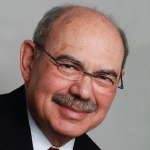 The traditional model for subspecialist consultations on hospitalized patients by outpatient-based rheumatologists may seem straightforward. Hospitalists (the inpatient specialists who now manage most in-hospital medical care in the majority of U.S. hospitals) typically call upon the rheumatologist’s expertise for joint swelling and a rash or fever of unknown origin, says Lianne Gensler, MD, of the Division of Rheumatology at the University of California, San Francisco (UCSF).
The traditional model for subspecialist consultations on hospitalized patients by outpatient-based rheumatologists may seem straightforward. Hospitalists (the inpatient specialists who now manage most in-hospital medical care in the majority of U.S. hospitals) typically call upon the rheumatologist’s expertise for joint swelling and a rash or fever of unknown origin, says Lianne Gensler, MD, of the Division of Rheumatology at the University of California, San Francisco (UCSF).
Relevant clinical conditions may include acute flares of lupus, vasculitis or gout. Perhaps the patient presents to the emergency department with symptoms but hasn’t previously received a rheumatologic diagnosis, or maybe the hospitalist just has questions about whether symptoms may be rheumatologic. “You don’t have to be sure the patient has a rheumatologic disease to call us,” Dr. Gensler says. “We like to be asked.”
But what if a rheumatologic consult is not readily accessible? Recent research from the ACR has documented anticipated shortages of practicing rheumatologists, estimated at 700 today and growing to 4,000 by 2030, with the current system of medical education unable to graduate enough new rheumatologists to fill the gap.1
Some of those in practice today have found visiting the hospital to perform consultations no longer fits into their busy outpatient schedules or no longer can be justified financially under the current healthcare system. Hospital consultations are relatively poorly paid for the time they take, and there’s no compensation for being on call for unpredictable consultation requests.

Dr. Gensler
Dr. Gensler spoke about these dilemmas at the most recent annual UCSF Management of the Hospitalized Patient conference held October 2018 in San Francisco. “Some hospitalists at the conference told me they no longer have access to rheumatology consultations because their community’s rheumatologists won’t go to the hospital anymore. Part of that may be driven by the workforce shortage, rather than by rheumatologists not wanting to be helpful,” Dr. Gensler tells
The Rheumatologist.
In other cases, hospitalists may not think of a rheumatic diagnosis, or may call the rheumatologist for issues clearly unrelated to rheumatologic disease or easily managed post-discharge in the outpatient setting. It’s important for the hospitalist to consider when to call or not to call, Dr. Gensler says. And yet there may be important clinical puzzles that must be solved.
For example, should certain rheumatologic medications—especially disease-modifying anti-rheumatic drugs or other drugs with immunosuppressive effects—be discontinued for the duration of a hospital stay? The acuity of hospitalized patients with rheumatic disease has gone up dramatically in recent years, says David Daikh, MD, chief of rheumatology at the San Francisco VA Medical Center and director of the Rheumatology Fellowship Program at UCSF. “Fewer rheumatologic patients have to be hospitalized than in the past, due to improved care. But the patients that need to be hospitalized are very sick.” Other subspecialists may also be involved, offering conflicting recommendations the hospitalist must reconcile.
But many hospitalists did not receive a lot of rheumatologic education in their internal medicine training (especially for the less common conditions) and may not appreciate all of the systemic manifestations of an autoimmune disease such as vasculitis or lupus. A constellation of symptoms involving multiple organ systems with signs of inflammation, fevers of known origin or shortness of breath with inflammation may exist. Patients with advanced rheumatoid arthritis or ankylosing spondylitis may have special considerations regarding intubation. A common question for hospitalists: Could this be lupus? What about renal dysfunction secondary to lupus? How do we interpret these laboratory findings?
These kinds of questions may prompt hospitalists to consult a rheumatologist. But they will want answers quickly due to the imperatives of discharging the hospitalized patient as quickly as feasible.
‘Some hospitalists … told me they no longer have access to rheumatology consultations because their community’s rheumatologists won’t go to the hospital anymore.’ —Dr. Gensler
Competing Priorities
Dr. Gensler says one of the biggest points of potential conflict between the two specialties lies in their competing priorities. Hospitalists are focused on length-of-stay optimization, but rheumatologists would like more time to get essential diagnostic workups done. “That is the struggle,” she says.
“We need to help hospitalists better understand what information we want and why the timeliness is important. These are patients we advocate for.” She offers an example of a hospitalized patient with inflammatory arthritis and Crohn’s disease whose imaging study uncovered inflammation of the aorta and retroperitoneum.
A biopsy was performed, but the patient was discharged two hours before inadequate sampling results came back indicating lymphoma. Because of a hitch in transmitting this information, Dr. Gensler says, “there was a three-week delay before the next appropriate opportunity to perform tests needed to confirm the lymphoma diagnosis. This was not optimal for patient care.”

Dr. Gross
Andrew J. Gross, MD, the Rheumatology Clinic director at UCSF, says many rheumatologists have been frustrated by consultations requested by a hospitalist that should have happened sooner, especially if the patient has already been started on steroids. “The hospitalist may request an urgent evaluation at a time when we are still seeing patients in clinic, or right before the patient’s discharge, which can make it challenging for the rheumatologist to provide an adequate evaluation,” he explains.
“But it is important for rheumatologists to recognize that hospitalists are under tremendous pressure to reduce length of stay and to be effective stewards of hospital resources. For them, anything that slows the process can be frustrating. They feel it would be faster for the rheumatologist to just come and take a look at the patient, and they get frustrated with indecision.” It can also prove frustrating when consulting specialists request more extensive workups, such as biopsies, which increase resource utilization, delay treatments and prolong hospitalization, Dr. Gross says.
When It Works Well
Bradley Monash, MD, a hospitalist at UCSF, says these types of conflicts represent the minority of interactions between hospitalists and rheumatologists at UCSF. “We have an incredible relationship with the rheumatology consult service. There are many situations where it would be helpful to have a rheumatologist weigh in, and we take advantage of that. They are an essential aspect of our care,” he says. “I recently met with Dr. Andrew Gross from the rheumatology service, who requested more routine engagement of rheumatologists with patients admitted to the hospital medicine service.”

Dr. Monash
But in other settings, including community and small hospitals, rural areas and communities located some distance from academic medical centers, access to a subspecialist can prove difficult. Another factor is the rheumatology group itself: Is it fully staffed? Is it asked to consult at multiple hospitals, each with its own idiosyncratic electronic medical record? What about traffic and parking? How are consulting responsibilities divided up and assigned? What if it is a small group or solo practice, or if the group provides no dedicated time for hospital consults? What does the health system or the employing multi-specialty medical group say about these issues?
The rheumatologist is a cognitive doctor more than a proceduralist, and is a highly accomplished diagnostician, notes Neal Birnbaum, MD, a rheumatologist in practice at the California Pacific Medical Center in San Francisco. “Sometimes it’s easier for us to talk to the hospitalist on the phone instead of just coming in and looking at a chart. When I was starting out in practice, I’d start my clinic hours at 1 p.m. after spending all morning driving from hospital to hospital. Today the average rheumatologist has almost nobody on their inpatient caseload in any given hospital. Trekking over there to see one patient is just not time-productive,” he says.
“I can step away from a patient to take a call from another physician,” Dr. Birnbaum says. “It may save more time to just give the information over the phone rather than in person, but there’s very little opportunity to bill for that kind of interaction. If it happens occasionally, it’s not a problem. You can tell the hospitalist over the phone what lab tests you think are needed. Once the results are available, the patient can be seen either in the hospital or outpatient setting if a face-to-face evaluation is needed.”

Dr. Birnbaum
Dr. Birnbaum adds that the timely availability of a rheumatologic consult can improve diagnosis accuracy while potentially shortening hospital stays and lowering overall costs of care, because the right diagnosis and treatment strategy are reached faster. But are some patients being imperiled today by lack of access to these timely and accurate consultations?
“Your question encouraged me to contemplate these issues,” says Christopher Frost, MD, SFHM, a hospitalist in Nashville, Tenn., and current president of the Society of Hospital Medicine, the professional association for hospitalists. “Multiple specialties are not coming to the hospital as frequently as they did in the past—not just rheumatologists, but also neurologists, dermatologists and endocrinologists. This could be driven by supply and demand, and by doctors asking themselves the question, ‘Where can I have the greatest impact with my time?’
“The foundational key to success has to do with communication, in order to maximize efficiency and relationship effectiveness. How do you hardwire that communication into the relationships? You need to sit down across the table from each other and talk about establishing mutual rules of engagement.” Can the two sides agree on what is urgent, what ought to be standard practice and how consults and discharge planning should be handled? But it must be done proactively, not in a moment of crisis, and the conversation can’t be just one and done, Dr. Frost says. “We both need to shoulder the responsibility of getting needed information to each other.”
He adds that it’s not uncommon for hospitalists to go out and meet with other physician groups (such as primary care physicians) to talk about how to strengthen working relationships. “Rheumatologists would be an excellent group to engage in this type of conversation,” he says.
Effective relationships impact more than just clinical care delivery. They can make huge contributions to the patient’s experience of care, Dr. Frost says. “It’s very powerful for me to say to a hospitalized patient, ‘I am going to communicate with your rheumatologist before you go home.’”
Enhance Access & the Relationship

Dr. Frost
The relationship between the hospitalist and the rheumatologist, like any relationship, can be enhanced through better and more purposeful communication, which starts with talking to each other. What does the rheumatologist want the hospitalist to know about rheumatologic conditions and their management, and when would the rheumatologist like to be called? What types of conditions or clinical questions should make a consult standard operating procedure?
Other communication methods with hospitalists and other inpatient physicians could help optimize the consultation process, Dr. Gross says. Because notes in the electronic medical record or faxes can take time to read and may fail to communicate a subtle sense of urgency, sometimes email or instant messaging (with secured encryption) can be more efficient and effective.
A phone call may be possible when a visit to the hospital isn’t, especially if the rheumatologist isn’t available until the end of the day. The rheumatologist could provide education for hospitalists, perhaps through brown-bag lunch presentations. Could one member of the hospitalist group volunteer to seek further training on behalf of the group? Is there a larger role for physician assistants and nurse practitioners to help with communication?
If the two groups are part of the same health system with a shared electronic medical record at the institutional level, could that record be leveraged for timely alerts and notifications? If the hospital doesn’t have access to a rheumatologist, does the sicker patient get transferred to an academic medical center? And can that process be improved?
Finally, telemedicine, including remote video access, may also supplement the consultation experience when in-person visits are hard to come by. Much of the rheumatologic assessment demands careful hands-on examinations, but some rashes, for example, could be diagnosed remotely on video. However, sources say this approach has not been widely implemented yet among rheumatologists.
“Everyone has their own style and approach to consultation,” Dr. Gensler concludes. “At the end of the day, we all have the same common imperatives, which should revolve around the patient. If we can keep the patient at the center of our relationship and focus on how to care for that patient in the best possible way, we will learn how to communicate better with each other. The consultative relationship can become a living, breathing process.”
Larry Beresford is a medical journalist in Oakland, Calif.
References
- Battafarano DF, Ditmyer M, Bolster MD, et al. 2015 American College of Rheumatology Workforce Study: Supply and Demand Projections of Adult Rheumatology Workforce, 2015–2030. Arthritis Care Res (Hoboken). 2018 Apr;70(4):617–626.
